In recent weeks the handling (or rather mishandling) of the Trump administration’s release of the “Epstein files” has splintered his base while also reviving public interest in the acts and history of Jeffrey Epstein. Claims have been made from figures like Elon Musk, a former ally turned critic after a highly publicized falling out, that Donald Trump himself is somehow implicated in the Epstein files – a term generally referring to documents the U.S. government has about the Epstein case that it has yet to publicly release. Meanwhile, some allies of Trump in politics and media have come to the president’s defense while others remain puzzled about the administration’s actions due to campaign promises of releasing these documents. Democrats in Congress, who have largely avoided discussing the Epstein case much at all in recent years, seem to smell blood in the water and are now publicly lobbying for the documents’ release.
Trump, as a political phenomenon, has long been able to brush off the most scandalous of leaks and recordings of lewd behavior that have emerged since he burst onto, and forever changed, the U.S. political scene. However, the fallout from the administration’s recent handling of Epstein-related information seems to have dented Trump’s reputation as “Teflon Don.” Given the prominent role the Epstein case played in Trump’s 2024 campaign and the administration’s recent communications, it is worth examining in greater detail some of the relatively unknown connections that could have helped shape what many are now calling a cover-up.
In this new series from Unlimited Hangout entitled “First Friends,” we will examine close friends and associates of the current president who also boast considerable connections to Jeffrey Epstein and/or his best known accomplice Ghislaine Maxwell, including one who currently serves in an important post in the Trump administration. While some have posited that Trump himself may be significantly implicated in the Epstein scandal – a possibility worth considering – this series aims to show that these long-time Trump pals could also be part of the motivation for the administration’s dramatic aboutface on the release of most Epstein documents.
In the first installment of this series, Unlimited Hangout examines the Italian businessman Flavio Briatore, sometimes referred to in the press as “Italy’s Donald Trump” because of his long-running friendship with the current president, and how his rise to prominence and wealth was fueled by a series of seedy associations to the same network of organized crime and intelligence operatives that also aided the rise of Epstein. As detailed in the two-volume book One Nation Under Blackmail, this network is ultimately controlled by powerful financial interests and unaccountable mob-linked oligarchs who have made powerful nation states, including the U.S., their play thing. This article will also detail how Briatore, along with Donald Trump and others, were once accused by Epstein’s butler Alfredo Rodriguez of being “material witnesses” to Epstein’s sex trafficking crimes. Rodriguez died in 2014 shortly after serving time in prison in relation to his failed efforts to sell the now infamous “black book” of Jeffrey Epstein.
However, first, this article will examine the supermodel Naomi Campbell, who was introduced to Epstein by Briatore – her one-time fianceé and subsequently “her mentor.” Campbell later flew on Epstein’s plane and, shortly after ending her relationship with Briatore, became romantically involved with the rapper Diddy, who would remain her close friend years after their romantic flame went out. Diddy’s own sex trafficking scandal and trial has been a focus on media attention for much of the past several months and Campbell has been accused of involvement in Diddy’s alleged criminal activity.
Ultimately, the picture that emerges when looking at Briatore’s and Campbell’s connections again underscores how the Epstein scandal is, in many ways, “too big to fail” as it risks exposing a nefarious yet wide-reaching power structure that could lose its grip if widely exposed.
The Models and Moguls of the “Black Book”
Naomi Campbell, born in Britain to parents of Jamaican origin, began her modeling career in the mid-1980s at age 15. Prior to that she appeared in music videos for Bob Marley and Culture Club and in the Pink Floyd film The Wall. She enjoyed commercial success a few years later, in the late 1980s, and cemented her standing as one of the world’s most iconic supermodels during the 1990s. She first modeled for the Leslie Wexner-owned Victoria’s Secret in 1996, a year after the lingerie brand began its once very popular televised fashion shows. Those shows, until they were suspended in the wake of the Epstein scandal in 2019, attracted “more viewers than all other fashion shows combined” and were run by the Chief Marketing Officer of L Brands (Victoria’s Secret’s parent company) Ed Razek. Razek, who was later accused of inappropriate behavior toward company models, along with some of the brand’s top modeling talent – including Campbell – can be found in the now infamous contact book of Leslie Wexner’s long-time fixer and now deceased sex trafficker, Jeffrey Epstein.
Campbell, for much of her early career, was represented by Elite Model Management. Elite had been founded by John Casablancas who was open about his sexual preference for “child women” and he had several affairs and relationships with 16 and 17 year olds. In a now suppressed BBC documentary from 1999, Elite agents were depicted “boasting of sex and drug exploits with young recruits.” Elite came under scrutiny a few years ago due to Donald Trump’s political fame, as his daughter Ivanka began modeling for Elite at age 15, wearing what the New York Times described at the time as “sexy outfits,” including a “see-through white dress,” while “still chubby in the cheeks with baby fat.”
Campbell was 17 when she began working for Elite, after Elite bought out the agency that had first signed her in 1987. Elite and Campbell parted ways in 1993, with Casablancas accusing her of being “crazy, irrational and uncontrollable” and mistreating staff. Campbell claimed that she had quit and that, contrary to Casablancas’ claims, she hadn’t been fired. Campbell has been accused of a series of assaults and for mistreating staff on several occasions over the past three decades. As noted above, a few years later, she became a prominent fixture at Victoria’s Secret fashion shows, appearing at the annual events from 1996 though 2005.
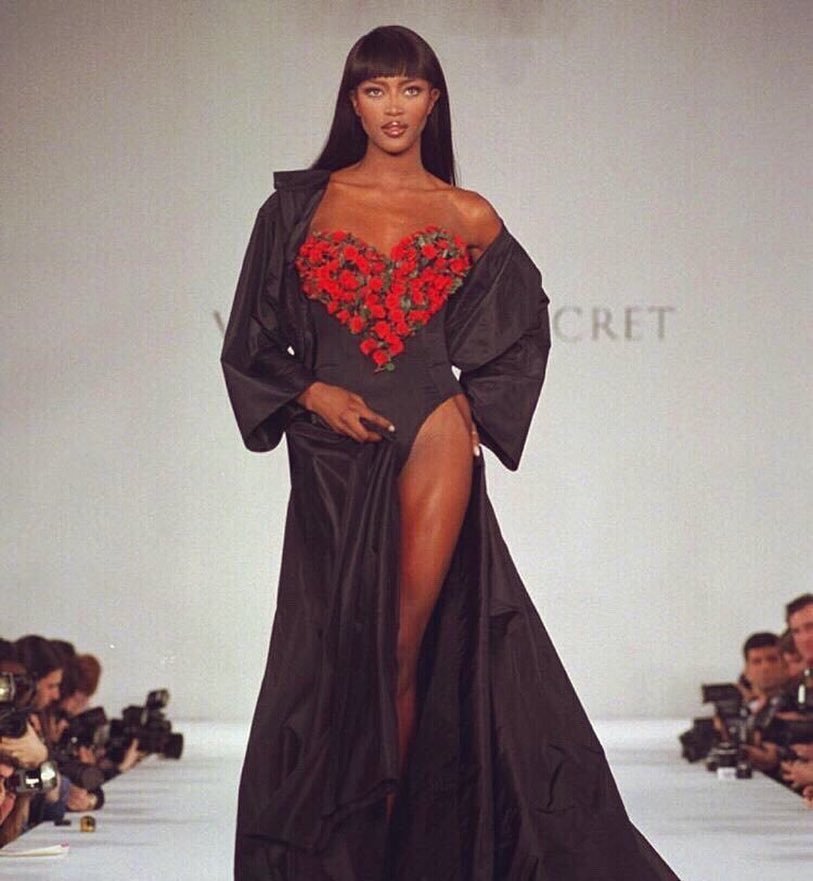
Jeffrey Epstein attempted but ultimately failed to acquire Elite’s American branch in the early 2000s. However, another close associate of Epstein’s, model turned businesswoman Nicole Junkermann, was also managed by Elite in 1995 and this may be how she first became acquainted with Epstein some time between the late 1990s and the early 2000s. As will be noted later, this is also roughly the same time frame in which Campbell claims to have first met Epstein. Junkermann, in 2002, allegedly assisted Epstein in sexually blackmailing two U.S. Senators (the identities of which still remain unknown) at a Wexner-owned residence in the United Kingdom, suggesting that some of the relationships Epstein cultivated with certain models was related to sexual blackmail efforts.
Epstein began to focus heavily on the modeling industry in 1995, several years after he teamed up with Wexner. Some evidence, however, suggests that Epstein had become very involved with recruiting models for Victoria’s Secret (or at least claiming to do so) as early as 1993. However, 1995 remains a significant year for Epstein in the modeling industry. That year, Epstein first teamed up with Jean Luc Brunel, a controversial model agency mogul from France who – much like Epstein – died suspiciously in prison in 2022 while awaiting charges related to the Epstein scandal.
Brunel, who is believed to have played a major role in Epstein’s sex trafficking enterprise, had brought Epstein into close connection with Faith Kates of Next models, “one of the most respected agencies in the industry,” who was a former business partner of Brunel’s. Epstein continued to have a close relationship with Kates and Next well after Brunel and Kates severed their business arrangement in 1996. As previously mentioned, 1995 was also the year that Victoria’s Secret began its fabulously successful annual fashion show and it was also the time that Epstein successfully began to portray himself as either being “in charge of Victoria’s Secret” or sometimes as one of the brand’s most prominent modeling scouts. As noted in the book One Nation Under Blackmail Vol. 2, Epstein used his connections to the modeling industry, particularly his ties to Victoria’s Secret, as a lure to so many aspiring models it was later characterized in media reports as “an Epstein-Victoria’s Secret pimp pipeline.”
Some in the industry even referred to Epstein as “one of the most important people in modeling” in the late 1990s. His connection with the modeling world persisted up until his first arrest in 2007, particularly his ties with Jean Luc Brunel. With Brunel, an apartment complex owned by a company run by Epstein’s brother Mark was said to have housed underage and just-of-age girls mainly from Eastern Europe and South America. Some (and likely many) of the girls and young women had their travel documents confiscated by Epstein associates and were coerced into having sex with powerful men. One of the models that flew on Epstein’s plane and traveled to his island, Ruslana Korshunova – a model for Vera Wang, DKNY and others – jumped to her death from her ninth floor apartment roughly two years after her trip with Epstein. The reason for Korshunova’s suicide remains unknown.
In addition, Epstein’s black book of contacts confirms that he certainly did have influence within the modeling industry. Aside from his aforementioned ties to Faith Kates and Brunel, his black book includes listings for Tom Ford, then the creative director of Gucci, as well as Ford’s long-time partner Richard Buckley, a “titan of the fashion media world.” In addition, famous models like Naomi Campbell, Janice Dickinson and Chis Royer also appear in the black book. Campbell is not only listed in Epstein’s black book and also owes the Epstein-connected Victoria’s Secret much for their commercial success, she is also intimately connected to one of the few “untouchable” figures around Epstein that was once flagged by Epstein’s own butler of having considerable knowledge of or involvement in his criminal enterprise. His name? Flavio Briatore.
Epstein’s black book of contacts, arguably now one of the most infamous contact books in the world, contains many names, but only a few names are circled. The book, along with the annotations such as the circling of certain names, was originally produced by Epstein’s butler Alfredo Rodriguez, who attempted to sell the book to Epstein victim lawyer Brad Edwards for a significant sum. Rodriguez made several notes in the book that he said would be important to solving the case, with most of the circled names – unless otherwise noted by Rodriguez’s annotations – referring to alleged co-conspirators and “material witnesses” of Epstein’s sex crimes. Edwards, who works alongside career U.S. intelligence mop-up man and lawyer Stanley Pottinger (who, like Edwards, is also a prominent Epstein victim lawyer), reported Rodriguez to the FBI. The FBI then set up a sting operation to obtain the book from Rodriguez, who was later charged by the government with bribery and obstruction of justice. Rodriguez then went to prison and died in 2014, the same year the black book was published by journalist Nick Bryant and Gawker. Bryant told Vanity Fair in 2019 that he gained access to the black book around 2012 after the FBI had obtained it and ultimately published with Gawker after many prominent media outlets declined to publish his articles about the book and the Epstein case in general.

In the black book, Rodriguez had circled Briatore’s name, along with the names of Leslie and Abigail Wexner, Jean Luc Brunel, Ghislaine Maxwell, Sarah Kellen (an Epstein assistant and recruiter protected by the so-called “sweetheart deal”), Peter Soros (nephew of the infamous financier George Soros), Glenn and Eva Dubin (close friends of Epstein with the latter also being his ex-girlfriend), Ehud Barak (former Israeli Prime Minister and former head of Israeli military intelligence), Bill Richardson (former Democratic Governor of New Mexico named by prominent Epstein accuser Virginia Giuffre), Alan Dershowitz (Epstein’s friend and former defense lawyer) and current U.S. president Donald Trump. In the case of Trump as well as the other circled names, it is unknown why specifically Rodriguez singled them out – e.g. were some of the names once “clients” of Epstein’s sex ring? Which were “material witnesses,” enablers or direct accomplices?
Ultimately, aside from Maxwell, Brunel and Epstein himself (one alive in prison and the other two found dead under unusual circumstances while in prison awaiting trial), none of the other circled names have been meaningfully investigated or pursued by law enforcement, Flavio Briatore included.
The Life and (Alleged) Crimes of Flavio Briatore
Flavio Briatore was born in Verzuolo, Italy and, after a failed restaurant venture, moved to the city of Cuneo. There, he became the assistant to local financier Attilio Dutto. Dutto was the owner of the Paramatti Vernici paint company, whose previous owner – Sicilian banker Michele Sindona – had laundered proceeds from heroin sales for the Gambino crime family. Sindona, in addition to his extensive mob ties, was also an adviser to the scandal-ridden Vatican Bank (officially known as the Institute for the Works of Religion) and a member of the infamous Freemason lodge “P2.” P2, also known as Propaganda Due, spawned a massive political scandal in Italy, as its members included mobsters, powerful businessmen, well-connected bankers and important politicians — many who were allegedly tied to the CIA’s Operation Gladio. P2 notably overlapped with Permindex-CMC, which Jim Garrison (and several researchers since) implicated in the conspiracy to kill John F. Kennedy.
During the early 1990s, another member of P2, former Italian prime minister Silvio Berlusconi, would become one of Flavio Briatore’s longest-standing and closest friends. Berlusconi’s long-time holding company, Fininvest, is alleged to have made annual payments of 200 million lira to the Silician mafia for an unspecified period after the company was founded in 1975. He was later accused by multiple parties of continuing involvement with organized crime, often in the pursuit of business (and later political) favors, throughout the 1980s and the 1990s. Berlusconi, the subject of numerous investigations for corruption, is also known for reportedly having an appetite for underage girls, with his conviction for hiring an underage “prostitute” while Prime Minister of Italy and using his authority to attempt to conceal the crime. His wife left him due to his “surround[ing] himself with minors.”
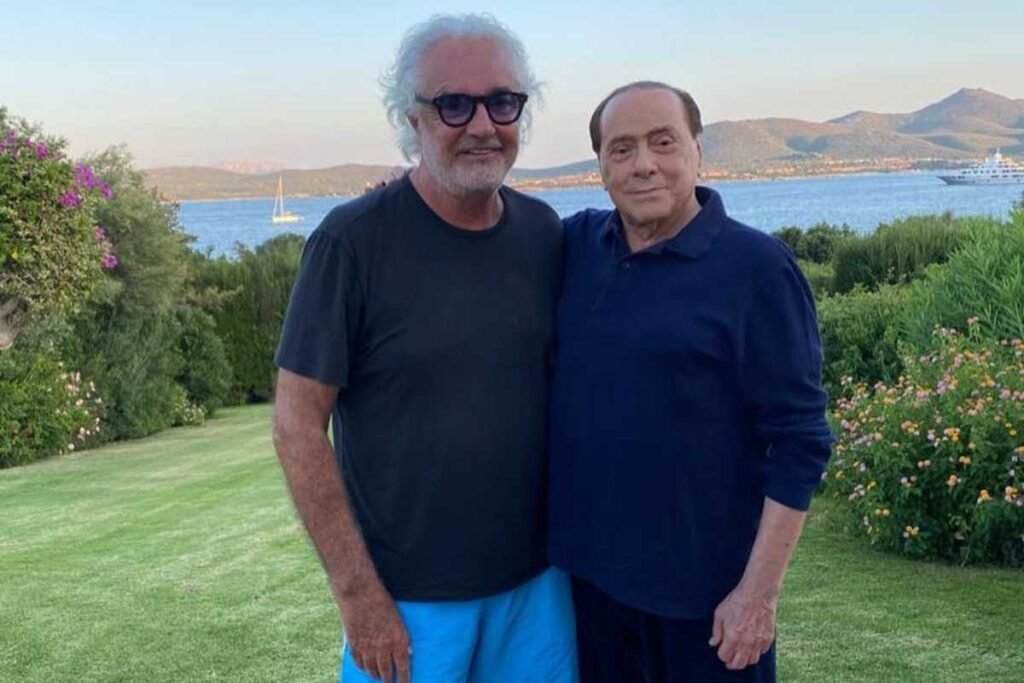
in an undated photo – Source
The later blossoming of the Berluscioni-Briatore relationship is suggestive that Briatore’s early connection to Dutto helped connect him into a world where the mafia and other powerful interests mixed in the shadows. Author Paul Williams, who wrote the book on the infamous Operation Gladio, wrote that Dutto’s predecessor Michele Sindona had been a “lynchpin” between organized crime networks (particularly those involving the National Crime Syndicate), the CIA and the Vatican, which eventually resulted “in the toppling of governments, wholesale slaughter and financial devastation” in post-war Europe. Several members of P2 were implicated in the conspiracy, including employees and members of the Agnelli family. The Agnellis, years later, would later become financially entangled with Jeffrey Epstein.
Sindona was also behind one of the biggest bank collapses in American history, Franklin National Bank. Sindona’s entry into the bank had been facilitated by Laurence Tisch, who sold a 20% percent stake to the bank to Sindona. Tisch would later become an important, founding member of the so-called “Mega Group” that was founded in 1991 by Leslie Wexner and Charles Bronfman. Most of its known members share historical and more current ties to these same organized crime networks as well as the broader network that enabled Jeffrey Epstein’s illegal acts.
Tellingly, Sindona’s successor at Paramatti, Attilio Dutto, was murdered just like his predecessor. While Sindona had died after drinking a cyanide-laced coffee in prison despite being under 24 hour police surveillance, Dutto died in a car bomb explosion in 1979 – a murder which still remains unsolved. Dutto’s then assistant, Flavio Briatore, immediately disappeared from Cuneo following Dutto’s death. At least one report has claimed that Briatore was charged with wrong-doing after Paramatti collapsed following Dutto’s death, though it appears Briatore never went to trial for anything related to Paramatti.

After Dutto’s murder, Briatore later reappeared in Milan, working for Finanziaria Generale Italia at the Milan stock exchange. While there, he became connected to the aristocratic Caproni dynasty, who had built their fortunes by dominating Italy’s aeronautical industry for many decades. In particular, Briatore became close to Count Achille Caproni di Taliedo, who was accused and tried for financial crimes against banks and other companies in the early 1980s via a holding company he controlled, Compagnia Generale Industriale (CGI). Notably, during this period, Caproni gave control over major aspects of that holding company to Flavio Briatore. However, Briatore was not charged for any potential role he may have played in CGI’s illicit activities or its 1983 bankruptcy.
In addition to the Capronis, Briatore also became acquainted with Luciano Benetton, the founder of United Colors of Benetton clothing company, during this period. That relationship would later prove critical to Briatore’s commercial success. However, not long after getting close to Benetton, Briatore was charged with several counts of fraud resulting from his ties to illegal rackets at Milan gambling dens. Those rackets were largely orchestrated and operated by successors to the Milan organized crime boss Francis Turatello. Evidence used against Briatore included a page from his personal agenda that listed a New York telephone number under the name “Genovese.” According to journalist Gianni Barbacetto, the number was registered to the G&G Concrete Corporation controlled by John Gambino, a well-known U.S. organized crime figure. Briatore evaded his prison sentence by becoming a fugitive, landing in the U.S. Virgin Islands, later a favorite haunt of a man who would soon become Briatore’s friend – Jeffrey Epstein. Notably, Epstein’s main patron and another circled name in his black book, Leslie Wexner, also had alleged ties to the Genovese crime family, according to heavily suppressed documents originally authored by Ohio law enforcement. Those documents resulted from the police investigation into the “mob style murder” of Wexner’s lawyer Arthur Shapiro, who was due to testify to the IRS shortly after he was killed. Shortly thereafter, Wexner hired Jeffery Epstein to sort out his “tangled” finances.
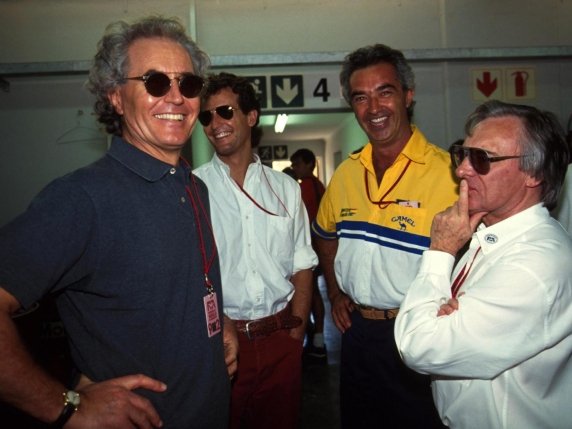
Around the time Briatore was charged and fled Italy for the USVI, he was chosen by Luciano Benetton to become “the Benetton Group’s principal representative in the United States.” During his time running Benetton’s North American operations throughout most of the 1980s, Briatore “ferried backwards and forwards between New York and the Virgin Islands tax haven,” becoming a “flamboyant member of the Italian-American business circles.” His forays into New York saw him become a partner at the most famous of the Regine’s Disco nightclubs. Regine, born Rochelle Zylberberg, was a European Holocaust survivor whose nightclub empire was originally bankrolled by Guy and Edmond de Rothschild of the infamous banking dynasty and they remained long-time patrons and supporters of her enterprise for decades. Presumably, Briatore met Epstein, as well as his friend Donald Trump, during this period.
Also during this same period, Briatore was tangentially involved in another scandal, one that involved an alleged effort to sell atomic bombs to Libya’s Muammar Gaddafi. This attempt to help make Libya a nuclear power had notably involved an infamous Saudi family tied to the BCCI (Bank of Credit and Commerce International) scandal and money laundering for drug cartels. The story, never fully investigated, goes something like this: a significant group of shares in the Italian insurance giant Assicurazioni Generali (aka the Generali Group) were passed around as part of a deal that benefited a small network of figures tied to Libya and/or Saudi Arabia with links to arms smuggling and money laundering. This particular group of shares “mysteriously left Italy” before returning to the country as collateral for “opaque international transactions” involving Libya, the Italian state oil company ENI and the smuggling of American-made weapons that traveled a serpentine route to ultimately end up in Libya despite the U.S. embargo.
The main figures involved in this memory-holed scandal included Anthony Tannoury (sometimes spelled Tannouri), a French-Lebanese arms dealer with close ties to Libya; Mazed Pharaon, a wealthy sheikh and the brother of the infamous BCCI investor and money launderer for drug cartels, Saudi “financier” Ghaith Pharaon; and Florio Fiorini, former manager of the Italian oil company ENI who had made significant, past deals with Libyan oil companies. A company that Fiorini controlled, Sasea, ultimately bought the shares, which were controlled by Tannoury, Pharaon and two of their associates. Tannoury and Pharaon had previously attempted to collaborate on a covert effort to sell nuclear weapons components to Libya by route of Venezuela. The effort was unsuccessful (some reports paint the effort as a scam orchestrated by Tannoury). Tannoury and Pharaon later claimed to have lost the $33 million that they had invested in the failed venture. As it relates to Briatore, a company he briefly controlled called Finclaus was one of the entities in this close-knit network that held onto the Tannoury-Pharaon-Fiorini group of shares in the Generali Group as it “toured the world.” Notably, the Benetton family, which has long-standing and deep ties to Briatore, are also long-standing shareholders of the Generali Group.
Nearly a decade after this scandal was covered up, Briatore’s London residence was bombed in 1993, allegedly by the IRA. Briatore survived the bombing and his house suffered minor damages. Notably, the IRA faction said to have been responsible had reportedly been supplied bombs and weapons by Libya. While it’s unclear why the Irish separatist militant group would choose to bomb Briatore’s home, his past ties to the figures involved with arms smuggling by way of Libya may provide one clue.
Another possibility could be that it wasn’t actually the IRA and another group angry at Briatore was responsible. The year before the bombing, there was a phone call intercepted by Italian officials the year prior between Briatore and Felice Cultrera, a Sicilian businessman. During the call, Briatore had asked about an effort by a mob-connected figure to sell engines to the Briatore-run F1 racing team owned by the Benettons (more on that shortly). The call was used as evidence as part of a large investigation targeting organized crime by the Italian state and it’s possible that interests angered by the investigation could have orchestrated the bombing to intimidate Briatore. Briatore notably became a major figure in the sale of engines to F1 racers and it’s unclear if his engine supply chain was ever connected to the organized crime networks that had approached him, as laid out in his intercepted call with Cultrera.
There is also other evidence that, in addition to the above, suggests Briatore had more than coincidental ties to the worlds of organized crime, arms deals and money laundering. In 2015, it was reported that Briatore held 38 accounts totalling $73 million in the private Swiss branch of HSBC, a bank later found to have enabled the activities of drug dealers, arms dealers, money launderers and terrorists. Reports suggest that Briatore’s accounts at the bank were closed in 2007, the year when the bank also “weeded out” clients who did not meet new standards meant to prevent the bank from enabling crime. Notably, the HSBC branch in question, where Briatore banked, was created after HSBC acquired some of the holdings of Edmond Safra and then took Safra’s “wealthy international clients” and moved their accounts to the new branch. It is unknown if Briatore was among these clients that had originally banked with Safra and Safra-controlled institutions, but – given Safra’s connections and Briatore’s own – it is plausible.
Safra was an international banker whose banking institutions were dogged by controversy, in large part due to scandals involving money laundering and organized crime. This includes those that later formed the basis of HSBC’s private Swiss branch where Briatore banked. Safra was a close associate and friend of Robert Maxwell – father of Ghislaine Maxwell and Israeli intelligence asset – and also appears in Epstein’s black book, though his last name is misspelled as “Saffra.” Safra had considerable ties to Russian organized crime, the state of Israel and the secret society of B’nai B’rith, where he served on the board of overseers alongside Edgar Bronfman and Leslie Wexner’s business mentor Max Fisher. Safra’s banks also had significant connections to the networks that operated the intelligence and crime-linked bank BCCI.
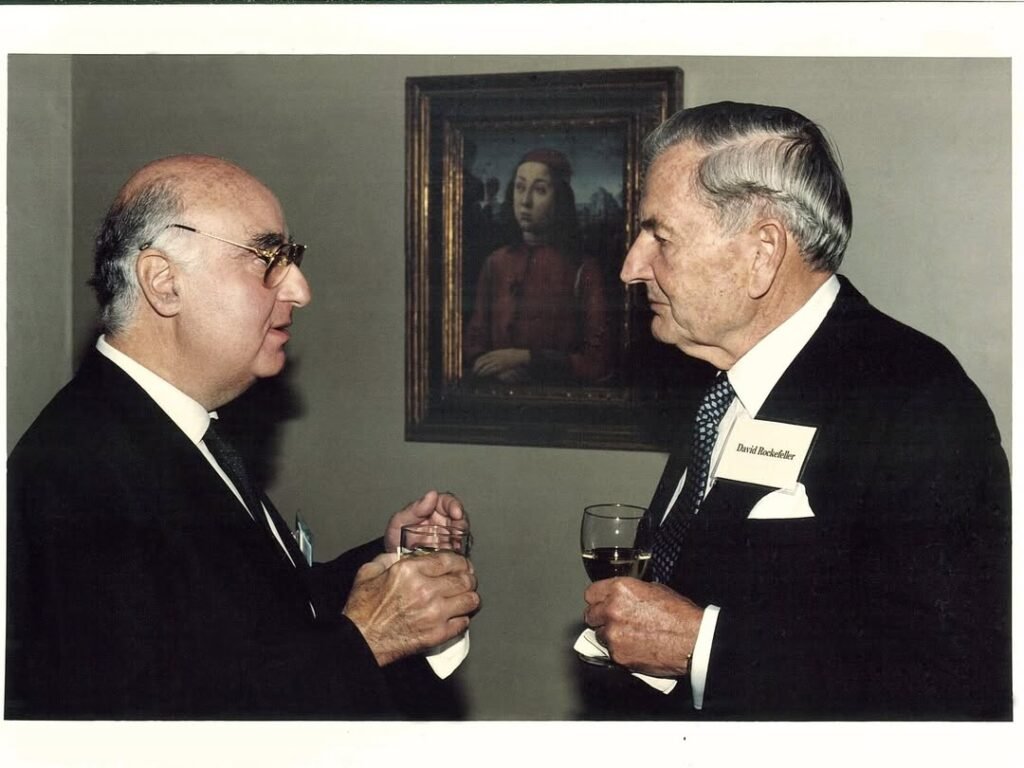
While weaving himself even deeper into organized crime networks spanning both the Old and New World, Briatore also became even more intertwined with Luciano Benetton. The Benetton family had formally entered the world of Formula One (F1) racing in 1985, acquiring an underperforming team it re-named Benetton Formula Ltd. Briatore was made commercial director of the team by Luciano Benetton and later became its managing director. Briatore is credited with making the team competitive and for its greatest successes, which occurred during the mid-1990s thanks to driver Michael Schumacher, who Briatore had recruited to join the Benetton team and who delivered two back-to-back championships. Schumacher left Benetton to join Ferrari in 1996 and Briatore was let go from the Benetton businesses in 1997. After the Benetton team was sold to Renault in 2000, Briatore rejoined it as executive director. His girlfriend at the time, Naomi Campbell, credits herself with setting up “an intervention dinner” with top F1 figures to persuade Briatore to return to the sport.
Briatore’s success at Formula One was later marred by scandal. A race fixing scandal in 2008 that favored Briatore’s then-star driver Fernando Alonso at the Singapore Grand Prix resulted in Briatore’s supposed lifetime ban from the sport. The investigation into scandal, known as “Crashgate,” found Briatore to have been complicit in the conspiracy, despite his denials. However, Briatore was later allowed back into the sport, with the Alpine team announcing in 2024 that Briatore was joining as an executive advisor. Meanwhile, the 2008 “Crashgate” scandal may have repeated itself shortly after Briatore’s return. Last year, a whistleblower claimed that F1 races were again rigged last year to benefit Fernando Alonso. Briatore is still said to be Alonso’s long-time agent.
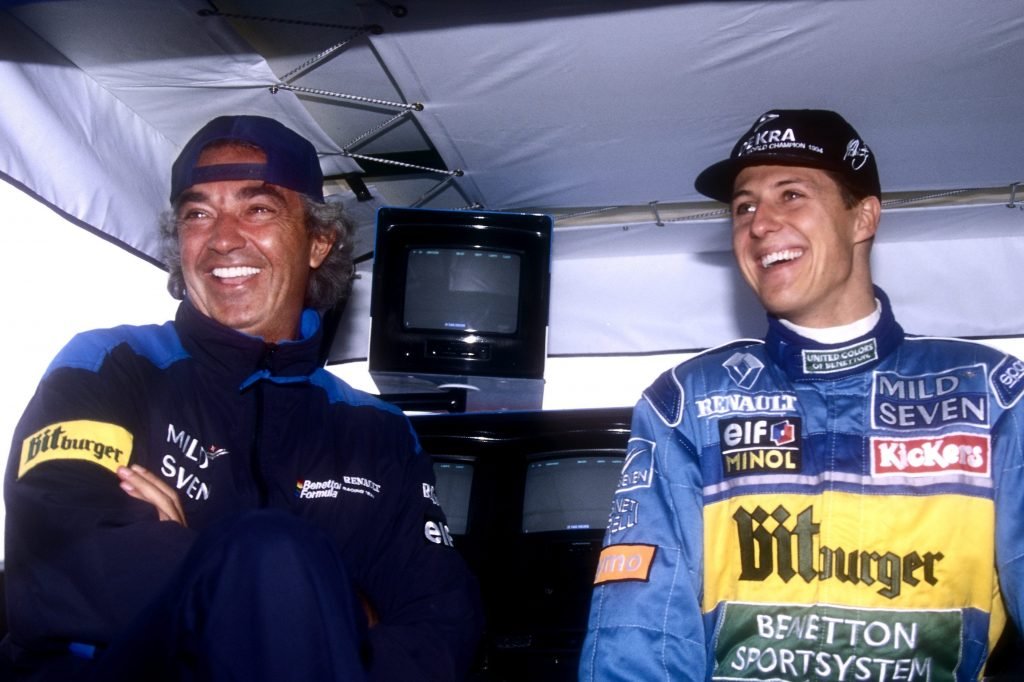
In addition to Flavio Briatore, numerous other important figures from F1 racing appear in Epstein’s book of contacts, including Bernie Ecclestone (who has long been very close to Briatore), Lawrence Stroll (who also has important ties to the fashion industry), and former star drivers Eddie Irvine and Jacques Villeneuve. Ecclestone and Briatore partnered in 2007 to take over the Queen Park Rangers football team, with Briatore leaving a few years later. The entry for Stroll, who made most of his fortune thanks to investments in fashion brands Tommy Hilfiger and Michael Kors, lists 17 phone numbers and two addresses, while the entry for Briatore lists – by comparison – 8 phone numbers and two addresses. Epstein’s former employee and alleged co-conspirator (who remains protected from prosecution by the “sweetheart deal”), Sarah Kellen, has ties to the U.S.’ F1 equivalent NASCAR via her husband Brian Vickers. Vickers notably filed for divorce earlier this year. It is worth mentioning that some F1 events have been accused of serving as “hubs” for human trafficking and that “young girls” in particular have been targeted.
By the mid-1990s, F1 and the Benettons had made Briatore rich and spurred his own ostentatious franchises focused on the rich and famous after being branded an “international playboy” (a phrase also once used to describe Jeffrey Epstein). For instance, in 1998, he opened the “Billionaire” nightclub brand, with its first location in Sardinia with others to follow. He later developed a conglomerate called Billionaire Life, a holding company for restaurants, luxury resorts and a haute couture fashion line. “With Billionaire, I didn’t just create a company,” Briatore later told Entrepreneur, “I created a lifestyle.” Thanks to Billionaire’s success, Briatore is now increasingly referred to in the press as a “hospitality mogul.”
Though Briatore’s Billionaire brand has holdings spread throughout the world, spanning Europe, the Middle East and Africa, his favorite place to build Billionaire brand businesses is now in Dubai. Briatore has developed several successful business ventures in the UAE as well as in Saudi Arabia’s capital Riyadh. Another developer who has long made major hospitality investments in the Persian Gulf, with more allegedly on the way, is Briatore’s close friend, U.S. president Donald Trump.
The Briatore-Trump Relationship
Briatore and Donald Trump first met during the late 1980s, though Briatore has declined to give an exact date. Briatore’s introduction to Trump was allegedly related to the fact that the two men – at the time – were trying “to start their careers after the stock market crash with the ‘Black Monday’ in 1987,” according to an interview Briatore gave on the Beyond the Grid podcast that was later the subject of a report by Motorsport. Per Motorsport, “It is not surprising that their paths crossed. The scene of playboys who wanted to get rich quickly was manageable even in New York at the time. You knew each other.” The two other New York-based “playboys” closest to Trump during this time were Jeffrey Epstein and Tom Barrack of Colony Capital, who still maintains close ties to Trump (now serving as U.S. ambassador to Turkey) and also to Briatore. At the time, Epstein was just beginning to work for Leslie Wexner and had spent much of the early to mid-1980s “hiding and finding stolen money” for powerful people. It seems likely that Briatore first met Epstein either via Trump (who broke ties with Epstein decades later over their competing efforts to purchase a Florida mansion) or Barrack, who is also listed in Epstein’s black book. However, unlike the listings for Briatore and Trump in that book, Barrack’s name was not circled by Epstein’s former butler Alfredo Rodriguez. Tellingly, Briatore has – to this date – never been asked about his Epstein relationship despite granting numerous interviews since Epstein’s 2019 arrest and death, making it difficult to know who first introduced them and the extent of their relationship.
Briatore stated that he grew even closer to Trump after officiating a meeting between the real estate mogul and Briatore’s then-boss Luciano Benetton. The meeting, which occurred some time between 1991 and 1992, occurred at the Plaza Hotel in New York, the site of Victoria’s Secret annual fashion shows, and whose suites were once used by a group of organized crime-linked figures to sexually blackmail powerful figures in government. Trump’s mentor and lawyer Roy Cohn, an organized crime associate, had been intimately involved in those blackmail efforts and Trump, after he bought the Plaza, was accused of hosting parties in Plaza hotel suites “where young women and girls were introduced to older, richer men” in which the women were allegedly exploited and illegal drugs were widely available. Around this time, Trump had also taken a controlling interest in Resorts International, an infamous mob-linked CIA front company that had formerly been known as the Mary Carter Paint company. Briatore claims to have introduced Benetton to Trump “because I was sure it was possible to do something together.” It is unclear what, if any, agreement Benetton and Trump may have reached during or after the meeting.
However, Briatore claimed that, after arranging this meeting, Trump offered him a job. Briatore elaborated that he had nearly turned down an offer from Benetton to deepen his involvement in the family’s F1 racing team because of the offer from Trump. “I wanted to go back to New York. I had an offer from Donald Trump to work for him in America,” Briatore told Tom Clarkson in 2020. In that same interview, Briatore also specified that the offer had been related to “the commercial side of his [Trump’s] new casino in Atlantic City.” Notably, Trump’s decision to acquire control over the mob and intelligence-linked Resorts International had largely been motivated by his efforts to develop Resort’s casino interests in Atlantic City, namely the Taj Mahal, which officially opened in 1990. A few years later, Trump ran into major financial trouble and was bailed out by Rothschild banking interests.
Though the two never ended up directly working together on any casino-related venture, they eventually did collaborate on “The Apprentice,” with Briatore starring in the series’ Italian language version as Trump’s counterpart. In the 2020 interview with Tom Clarkson, Briatore said that “I have always had a good relationship with him [Trump] […] When he decided to broadcast ‘The Apprentice’ in Italy, he wanted me for it. He said: ‘I want Flavio Briatore.’” Briatore was also chosen to star in the recent reboot of the Italian “The Apprentice” and has also claimed that Trump personally asked him in 2024 to become the series’ representative in Europe. Briatore turned down the offer, citing his commitment to his recent return to F1 racing, and added that Trump, at the time, had also requested Briatore visit him in Florida.
Briatore has also been very supportive of Trump’s political career, and has characterized Trump as a political moderate. During the 2016 election, Briatore had heralded his long-time friend as an “unparalleled talent” that regular Americans can identify with more easily than career politicians. Briatore also has praised Trump’s response to the Covid-19 crisis, in particular the “Going Direct” fiscal policy pursued by former Treasury Secretary under Trump, Steve Mnuchin, with the input of Trump’s former money manager Larry Fink.
In 2019, Briatore attempted to follow Trump’s trajectory from businessman to politician and launched his own political movement in Italy called Movimento del Fare. The move immediately drew comparisons to Trump, which “honored” Briatore. Briatore’s political party initially portrayed itself as a group of “successful businessmen and professional[s] that, together with theirs ideas and visions, will help the country recover, create jobs and attract investments.” However, it appears to have garnered little success and Briatore has since remained more focused on his growing hospitality empire. With respect to the 2024 U.S. election, Briatore reiterated his support for his friend’s bid to return to the White House.
Naomi Campbell – The Woman Who Connects Epstein and Diddy
Regardless of exactly how Briatore and Epstein met and who introduced them, the two knew each other well before 2001, when Briatore introduced his then-fiancé, supermodel Naomi Campbell, to Epstein. However, given her prominent roles in Victoria’s Secret fashion shows, a prior meeting is possible. Indeed, Campbell herself later said that “He [Epstein] was always front and centre at Victoria’s Secret shows.” When interviewed after Epstein’s arrest in mid-2019, Campbell denied knowledge of Epstein’s crimes and said she stood “with the victims.”
Photos from the occasion where Campbell claims to have first met Epstein – her 31st birthday party hosted on Briatore’s yacht – shows Campbell and Epstein associates in the same photograph. Those photographs are now rather infamous as they also show Epstein’s most prominent accuser, an underage Virginia Roberts (later Virginia Giuffre after her marriage), attending the party and following Epstein’s most notorious accomplice – Ghislaine Maxwell – around the event. Giuffre died earlier this year in April. There are other pictures of Campbell and Maxwell partying together in the early 2000s at subsequent events, suggesting the two became rather chummy after their initial meeting. Giuffre later alleged that Campbell and Maxwell had been “BFF,” i.e. best friends.
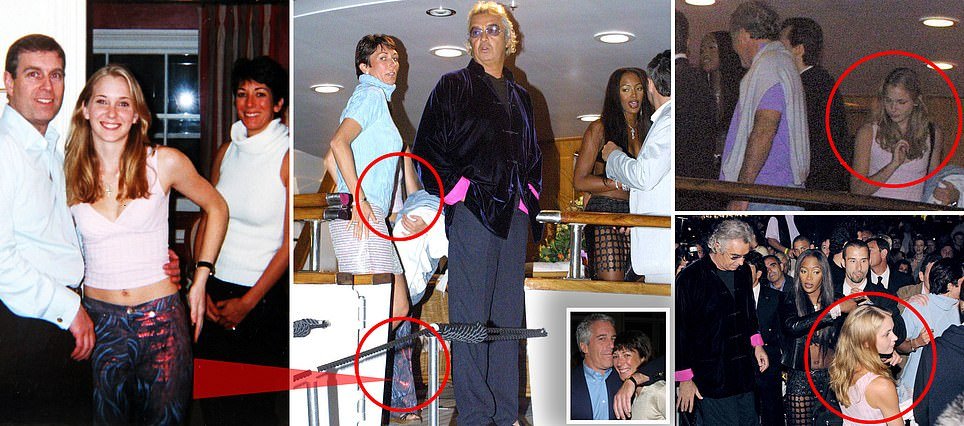
In addition, Campbell also flew on Epstein’s private jet five times after she met him, with those flights taking place between 2001 and 2003. One of the flights saw her travel with former president Bill Clinton. Two of the flights originated from the U.S. Virgin Islands, where Briatore had major long-standing connections and where Epstein’s infamous island was located. Campbell has not publicly commented on the flights or if she ever visited Epstein’s USVI island residence. However, she has said that she “ran in the same circles” as Epstein but has insisted that the two weren’t close.
In addition, some of the flights Campbell took on Epstein’s plane went to Brazil, a place where Campbell has said she would go out on the street and recruit teen girls for the modeling industry. The Miami Herald reported in 2018 that one lawsuit against Epstein claimed that he “used an international modeling agency [Brunel’s Mc2] to recruit girls as young as 13 from Europe, Ecuador and Brazil.” It is unknown if Campbell had played a role in those efforts while traveling to Brazil on Epstein’s aircraft. However, she was romantically linked to Briatore when most of the flights took place, and Briatore – as previously noted – is a circled name in Epstein’s black book. In addition, Campbell was accused of involvement in the sex trafficking scandal where her former boyfriend and long-time friend, the rapper Diddy, who recently stood trial for crimes similar to those reportedly committed by Epstein. One allegation claims Campbell was used by Diddy as a “lure” for his victims. If true, those allegations may offer cause to re-examine her flights on Epstein’s infamous jet.
Furthermore, Campbell was also accused by Epstein victims of being aware of his sex trafficking operation but doing nothing to stop it. Indeed, while Campbell has claimed to have known nothing of Epstein’s crimes and to support his victims, Virginia Giuffre tweeted at Naomi Campbell after his 2019 death, accusing her of knowing what was happening. “You saw me at your parties, you saw me in Epstein’s homes, you saw me on the plane, you saw me get my haircut, you saw me on the streets, you watched me be abused. You saw me!” Giuffre wrote in early 2020. In another tweet Giuffre said that “There is no way in hell that she [Campbell] didn’t know what was happening in front of her own eyes. They were all aware of Epstein and Maxwell’s op – didn’t go at [sic] to hide it either.” Notably, Campbell was also mentioned in the testimony of Epstein accuser Johanna Sjoberg.
Campbell began dating Briatore in 1998 and the pair dated for four years, ending their relationship in 2002. Some reports characterize their relationship as “on and off.” During this same period, Campbell was said to also have been dating rapper Diddy, with that relationship allegedly taking place in the year 2001, shortly after Diddy ended his relationship with Jennifer Lopez. That same year, in its October issue, the British edition of Vogue featured Diddy and Campbell on its cover with the headline “Naomi and Puff: The Ultimate Power Duo.” Some reports state they dated in 2002. Photographs also show Flavio Briatore partying with Diddy in the early and mid-2000s.
One interview Campbell gave to The Guardian in 2006 reported that Campbell “has always been attracted to older men, mentor figures.” The article added that “sometimes they have been boyfriends, sometimes she’s adopted them immediately as her dads.” With respect to those claims, Campbell was quoted as saying “I’ve got my dad Chris Blackwell. My dad Quincy [Jones]. I’ve got Flavio [Briatore]. And I have Mr. [Nelson] Mandela, my grandfather.” She later stated that she looks for “father figures” as boyfriends. Campbell later stated of Flavio that he was her boyfriend but had since become “her mentor.” They still maintain a friendly relationship.
Shortly after his split with Campbell in 2002, Briatore began dating another supermodel fixture at Victoria’s Secret fashion shows who is also incidentally in Epstein’s black book – Heidi Klum. Klum had been previously associated with Ghislaine Maxwell and Prince Andrew – another known associate of Epstein – who were photographed at her Halloween party in 2000. Maxwell was also photographed with Donald Trump and his then-girlfriend and later wife Melania at the same event. Melania had recently begun dating Trump, and Maxwell later claimed to have introduced them. Klum, like Campbell, was alleged by at least one Epstein accuser to have flown on Epstein’s plane. However, Klum denied the allegations.
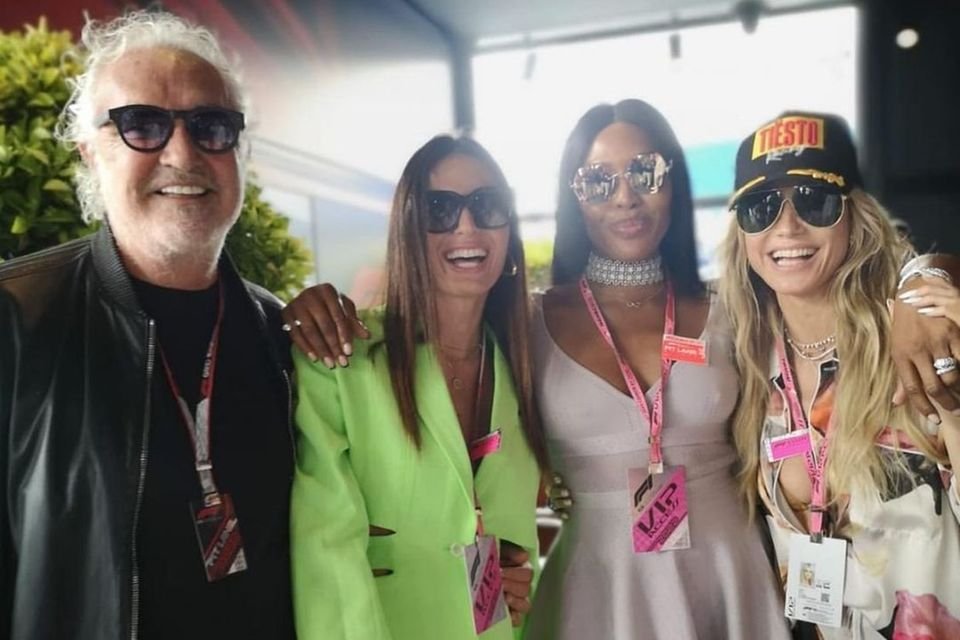
Briatore’s relationship with Klum was publicly announced in early 2003 (though it appears to have begun in 2002) and it ended in 2004. Despite the short nature of the relationship, it provided plenty of fodder for tabloids, particularly as the couple split shortly after Klum announced her pregnancy and the two argued publicly about where their child should be born. Briatore was largely uninvolved in the life of his daughter with Klum, who was later adopted by Klum’s next partner, the singer Seal. However, Briatore and his daughter have since been photographed together vacationing in Europe. Briatore’s subsequent wife of nine years, Elisabetta Gregoraci, is also a former lingerie model who is best known for being the chief model marketing the Wonderbra. The Wonderbra brand was then owned by the Sara Lee Corporation, which – for many years – was controlled and chaired by members of the organized crime-linked Crown family. The Crowns boast ties to the Epstein-linked “Mega Group” of billionaires and also played a major role in the hiring of Jamie Dimon to lead J.P. Morgan alongside banking interests tied to Leslie Wexner. J.P. Morgan would later be linked to Epstein’s crimes.
Campbell’s subsequent long-term relationship after Briatore also deserves a quick mention. Campbell began dating billionaire Vladislav Doronin in 2008 and the two split in 2013 after Doronin was photographed vacationing with another woman and embracing another model that he had met through Campbell. Doronin, a billionaire of Russia origin, made his money largely through his close-knit relationship with commodity trader and Mossad asset Marc Rich. Rich, a long-time fugitive from U.S. authorities with very close ties to Israeli intelligence, was also close to prominent figures in the “Mega Group,” namely Michael Steinhardt, who, alongside former Israeli prime minister Ehud Barak, allegedly helped pressure former president Bill Clinton to controversially pardon Rich right before he left office. Rich also had controversial ties to Bruce Rappaport, a shipping magnate and banker tied to U.S. and Israeli intelligence, as well as the criminal bank BCCI, which – in addition to banking drug cartels, intelligence agencies and financial criminals – also ran a sex trafficking operation where minors were abused at the hands of the bank’s “VIPs.”
Doronin began his career working for Marc Rich in Switzerland before founding the Capital Group in Moscow in 1991. Capital Group was originally a commodities trading firm that later turned into a real estate investment company and allegedly engaged in extensive commodities trading with Rich in its early days. One article published by Business Insider referred to Doronin as one of the people Rich had chosen to mentor. Doronin has since divested from Capital Group. Doronin’s subsequent main corporate vehicle, luxury hotel manager Aman, came under fire for hiring Charles McGonigal as its head of security. McGonigal, a former FBI agent, was arrested while working for Aman for taking secret payments from Oleg Deripaska. Deripaska, one of Russia’s richest men, started – like Doronin – as a commodity trader, later merging his aluminum mining interests with Marc Rich’s Glencore. The Rothschild family boasts close ties to both Deripaska and Glencore.
Who Pulls the Strings?
This article exploring the ties between Briatore, Campbell, Trump and Epstein does not intend to imply that the Briatore-Trump relationship alone has influenced the current administration’s failure to release the bulk of the so-called Epstein files. Instead, the connections between these individuals reveals that, as Campbell herself once noted, they all swam in the same corrupt circles, and that they share significant ties to people and entities linked to organized crime, corruption across various industries, and sex trafficking. The intricacy of these “circles” will only become more apparent in subsequent entries in this series.
Epstein himself was the management, not the owner, of the criminal enterprises that have now made him infamous. The tight-knit network of oligarchs that enabled Epstein are transnational as their influence spans several countries. They work to manipulate global affairs and global finance while staying out of the limelight themselves, with more public-facing “financiers,” moguls and politicians serving as their middle-men. These oligarchs are the truly unaccountable ones, and their recurring presence in the circles around Epstein, Trump, and some of their long-time, mutual associates appear to be the real reason for the mismanagement of the Epstein files’ release.
However, at least one figure in the Trump administration, aside from Trump himself, may stand to benefit from the administration’s failure to release the lion share of the Epstein-related documents in the government’s hands. As will be detailed in the second article in this series, a close friend of both Donald Trump and Flavio Briatore currently plays an outsized-yet-quiet role in Trump administration foreign policy in addition to having unsettling, yet largely unknown, ties to the Epstein scandal.
Correction: The original version of this article misstated that Alfredo Rodriguez was in prison the year he died. He died shortly after serving his sentence and this article has been updated to reflect that. This article had also originally linked to a Fox News article that stated that Rodriguez had died in 2015. However, other articles have claimed that Rodriguez died late December 2014, citing his wife. We have decided to go with these more detailed reports, now linked in this article, and have listed the year of death as 2014.






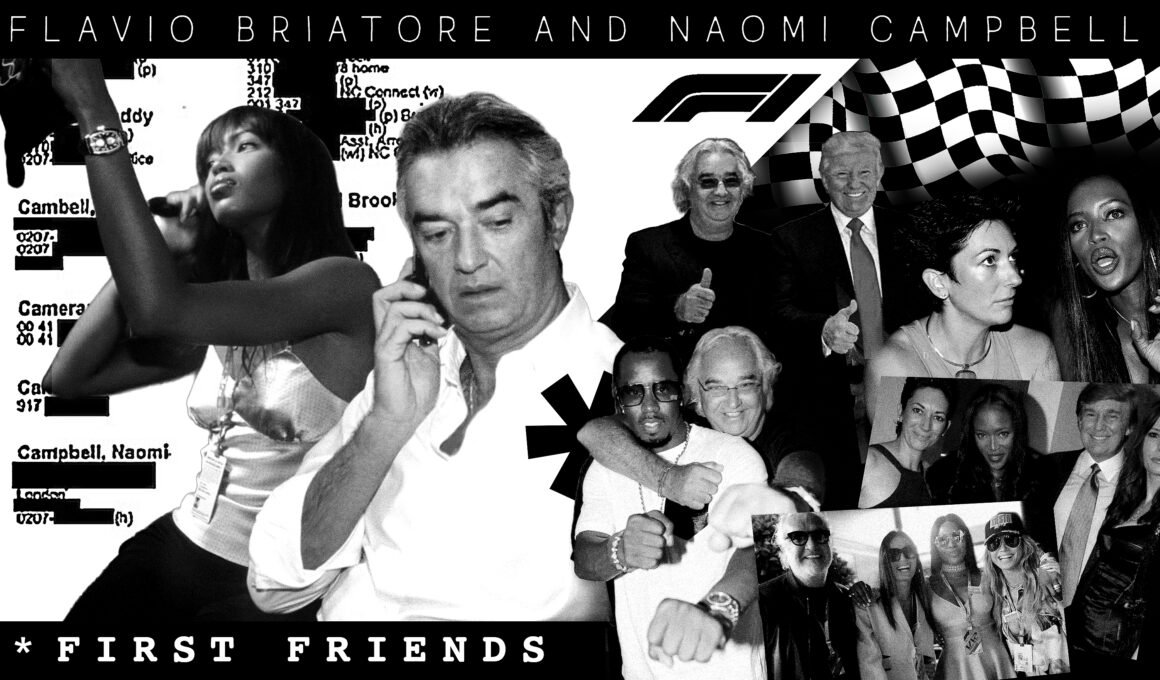
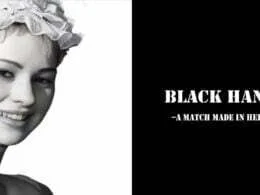
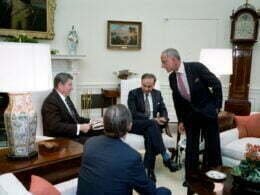
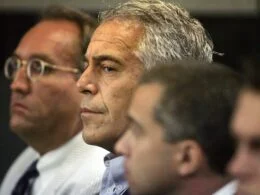

God Bless, you.
The first commenter said “may God bless you”, I believe God has blessed you in a pure heart…don’t let the bastards get you down Whitney — I’m an old man who has seen ‘this coming of age’ for a long time. I awoke far too early in life and paid a price for that insight. I now understand this is a war on a deeply spiritual level. I wish I could afford a subscription to your website and will try in the near future to get one… You are a necessity. I saw your interview on GTW and that inspired this reading of a fine article. If its any consolation I bought your two volumes (1st edition) when you first published — I have followed your work for a long time and wish you the best.
May you find the ultimate peace and love you deserve.
LOVE your work, but please dear god stop using your book as a reference in your articles lol. Your book is METICULOUSLY sourced, but it would be far more effective to just link to the source you listed in your book instead
I do love that you link to the PDF for anybody to download though. You are as real as it gets
Yeah, with all due respect I too want linked sources without needing to buy your book right now. Anyway, thanks for the detailed story
If you click the linked source, you will see that it links to the book that is free to search/read on archive.org.
You are so good, Whitney!!! I can’t wait until the next release. 🙂
OMGosh..your Research and Stoyline is Incredible…!
Keep up the great work! ❤️
Thanks!
Who is the rat to be featured in the next article?? I love the suspense! My money’s on Lutnick.
What’s up with Nelson Mandela always showing up in the sketchiest places? For example he was a friend of the Manitou Foundation’s Hanne Strong. Darling enough to be made into a psyop, what a disgrace.
Also, just a grammar thing, in the third section is a redundancy: ‘ The year before the bombing, there was a phone call intercepted by Italian officials the year prior between’
Thanks again for your fearlessness Whitney. You are an inspiration for a generation!
Yes, Whitney has left us with a cliff-hanger. My money is on Lutnick as well.
Those people are more grotesque than the Scrooge characters in Charles Dickens’ novels.
Love this!
Plus Whitney’s work, of course.
Excellent research 👍 can’t wait for the next installment.
Amazing research. Why are we not surprised at the links between high finance, celebrities, blackmail and power?
Trump is obviously knee deep in this world. It makes it even funnier the way his administration is trying to pretend there is nothing to see here. Their defense is that just because you’re in the black book (and your name is one of the few circled ones) doesn’t mean you are guilty of anything. Dershowitz was on Fox News spinning the same line and supporting Ghislaine testifying in Congress. Same as Tim Dillon on his show talking about his “meeting” with the administration in D.C. So obviously this is their genius strategy to make it all go away. And while they’re at it they’re going to give her a reduced sentence for “cooperating.” All i can do is laugh at how audacious and ridiculous the lie is, and how it’ll probably work.
It has to be Howard Lutnik, the current commerce secretary, and former CEO/Chairman of Cantor Fitzgerald which is one of the primary dealers for the Fed in the US and who’s offices were obliterated in the 9/11 attacks. He was neighbors to Epstein at his infamous New York residence and bought the building bought from a company tied to Epstein and Wexner in the 90s.
Already done. https://unlimitedhangout.com/2024/12/reportaje-investigativo/howard-lutnick-and-the-commandeering-of-the-department-of-commerce/
Thank God you’re back on this beat! What a cliffhanger ending! I try telling people your work on this is foundational, to read you if nothing else on the subject. Agree with someone else here, I’m thinking Howard Lutnick is the lead in for Installment 2.
There is a Nell Campbell listed among the “groupies” in the cast of Pink Floyd – The Wall (1982), the live-action/animated film directed by Alan Parker. Naomi Campbell does not appear in the cast listing.
Did you check her source that is linked? https://web.archive.org/web/20140809132920/http://www.vogue.com/voguepedia/Naomi_Campbell
Yes, see additional comments below. My point is that Naomi Campbell doesn’t appear in the published cast listing for Parker’s 1982 film. Small roles may not be credited.
We love you Whitney!!!! She should be protected at all cost.
Hey Whitney,
This is fantastic. Very important what you are relaying. The only thing you will need to correct is the fact you mentioned that Naomi Campbell had appeared in the motion picture Pink Floyd The Wall. She did not, a\and I believe you might’ve confused her with Nelly Campbell, who appeared in the movie portraying a groupie trying to gain access to the main character Pink (Bob Geldoff) after a rock show. Naomi was 11 years old at the time of filming as well.
The source is linked in the article. https://web.archive.org/web/20140809132920/http://www.vogue.com/voguepedia/Naomi_Campbell
The commenter’s assertion that Nell Campbell was underage in Pink Floyd – The Wall (1982) is obviously spurious. Australian actress Nell Campbell (aka Laura Elizabeth Campbell) was born in 1953. She is best known for her role as Columbia in the The Rocky Horror Picture Show (1975), and the original stage play from which the film was adapted.
The way I read that comment was that it was Naomi Campbell (not Nell) who was 12 years old at the time of the film, ie inferring that Naomi would have been too young to have appeared in that role in that film, not that the actor Nell was underage.
Webb cites the Voguepedia article claim that Naomi Campbell appeared “in the Pink Floyd film The Wall as one of the wild schoolchildren.” If the statement about Campbell is accurate, most likely her appearance would be somewhere in the “Another Brick in the Wall” live action scenes. Those child actors are not identified in the Internet Movie Database cast listing https://www.imdb.com/title/tt0084503/fullcredits/?ref_=tt_cst_sm for the 1982 film directed by Alan Parker. Twenty-three teenage pupils from Islington Green School in London sang in chorus for “Another Brick in the Wall” on Pink Floyd’s 1979 studio album The Wall.
thank you Whitney Webb! What a story!
May the truth be revealed; may people begin to understand the severity of our reality and may we be strong and honest to make sure, such things will never ever happen again.
Great work Whitney, we’re all indebted to you!
Superb
Love your research articles and how you tie up all the loose ends.
Great investigative work. It’s very odd and noteworthy that the “Black book” of Alfredo Rodriquez, Epstein’s butler, is omitted from any and all mainstream media mentions. Nothing to see here, when in fact it is the 800 pound gorilla in the room.
And what’s the common denominator? SteinBergman?
Don’t know how this would all make sense without you!!! Thank you Whitney!!
What evidence or sources do you have that Alfredo Rodriguez died in prison in 2015? Every source or report I was able to find has suggested that he was sentenced to 18 months in April 2011, released in late 2012, and died in December of 2014–2 years after release from prison. I could find no evidence that his sentence was extended, or that he was in custody for any other crimes at the time of his death.
Furthermore his wife Patricia Dunn reported to the Daily Mail that he had been suffering from mesothelioma, a form of cancer, for many months, and wrote a memorial to that effect on her Facebook page. What is your source or sources alleging anything to contradict the above?
First of all.. congratulations for the baby, wishing you and family all the best!!
Then, wow, you know about this man more than an Italian like me who has seen him on TV, news outlets, etc for ages…
However, just to give some more depth to the character, I will add that last year during an appearance in a podcast, he (in)famously said that he “doesn’t know how people live with (only) 4,000 euros/month…”. It became viral, obviously, since inflation and poverty in our Country are devastatingly gallopping, those who have a job earn an average of 4 to 8 euros/hour with contracts of 20 hrs/week that last only a few months, that’s the reality here. People who retired after 30-35 years have pensions of 1,000-1,300 euros/month, when nursing homes cost 2-3,000 euros/month… Anyway, that comment was of course not a surprise, coming from someone like him who is obviously detached from ordinary people and life.
=> https://www-repubblica-it.translate.goog/italia/2024/07/19/news/briatore_ma_come_fa_una_famiglia_a_vivere_con_4mila_euro_al_mese-423404080/?_x_tr_sl=it&_x_tr_tl=en&_x_tr_hl=it&_x_tr_pto=wapp
As for the investigation, here’s some more:
just a few months ago he and his ex-wife were mentioned by another character (ex latin lover, he then had a ‘paparazzi’ agency and went even to jail for tax evasion, his name is present in many scandals, extortion attempts, gossip, and so on related to the Italian most famous and rich. Anyway, in a video he posted on YT in May, about an old murder case (that is now under scrutiny), as said he mentioned also them, stating that E.G. was an escort before meeting him. Perhaps use the subs in English:
=> https://www.youtube.com/watch?v=7Zlo_inISoc&t=1074s
While searching for this video, I found also this article from 2020 where they publish a paragraph from a book this F. Corona wrote, where he says that he was the person who introduced E.G. to Briatore and that before that he had her posing as ‘girlfriend’ to other rich people…
=> https://www-corrieredellosport-it.translate.goog/news/gossip/2020/11/28-76869446/fabrizio_corona_elisabetta_gregoraci_e_briatore_vi_dico_tutto?_x_tr_sl=it&_x_tr_tl=en&_x_tr_hl=it&_x_tr_pto=wapp
Fascinating. I love your work. Thank you, Whitney.
PS. The caption under the picture with Berlusconi suggests he died in 2018, when he in fact died in 2023. Much love from Italy!
Hi Whitney Webb. I found a video that is really a formatted compilation of stuff on a youtube channel called “Only the SAVVY”, and it had a particular topic going on in regard to this Jeffery Epstein, and the point it was making was predominately based on video captures of you speaking on the things that you have found in your research. I haven’t finished the video yet, but plan to after typing this up. I left a comment on that video…I’ll put it here:
So who is this “Whitney Webb”? Is she personally accessible? I mean, I’ve looked to see if she does public speaking, but I haven’t found anything in regard to that, and I get it, especially the things that she brings to light…my guess is there are a lot of people sitting in high places that do not like what she is throwing out there. Or maybe she’s right in there with them, and is instructed to inform the general public of what position we’ve allowed ourselves to get into…I think it would be neat to have a personal conversation with her…well, if she’s really good at what she does, she probably could find me, ha! There are probably a lot of people like me that would like to have a one on one conversation with her…looks like it’s just videos, though. Thanks for this one; I’ll check out your channel, and I hope you and yours at Only the SAVVY youtube channel are doing great.
Now I’m not accusing you of “being right in there with them”…I don’t know you, so as you probably do in your research, you can find out about a person based on any historical information you can find out about them that can be legitimized, but that really isn’t like personally “knowing” someone; it is knowing “about” someone. I’m really not that great on reading to find out information on a topic…it’s like a drudgery for me, because my eyesight isn’t that great, but I do it when I deem it is worth the effort. You have such a back log of articles that I would really have to put a lot of time that I really don’t have to get a real gist of all the information you have shared with the general public, so I guess I’ll start with at least skimming. I do have a question, though: What do you think would make this thing in regard to Epstein really “real” to the general public, to where it’s not just sensationalism, but a real legitimate thing that is absolutely going on in regard to this Epstein entity? Also, it is very easy for me to consider the following: Is there just one cartel or faction that is involved in sophisticated producing and smuggling drugs or are there more than one? Is there only one cartel or faction involved in sophisticated and covert human trafficking? I could keep going with that train of thought, but to save time, I’ll get right to the point: If that is the case in regard to those things, I personally think it would be completely naive to know that this “Epstein” existed or exists, and not consider that there just might be a bunch of them, running a covert network of what he “specialized” in. So if there is one, how many more are there that continue in their “operation” completely undetected and covert, completely unscathed by what happened in regard to this “Epstein”? Maybe a covert network of them? Just something to consider. Boy, rambled on there, didn’t I? So if your not some “controlled op”, which I don’t think you are…I like to believe in the best of folks unless they give me reason not to…so again, if you aren’t all of that, I hope you and yours are doing great!
Whitney, your love is so strong in your investigative reporting. Digging so deep into the mainstream underworld, we are all bombarded with conditioning and sometimes influenced by our fears. Because truth is the first casualty in war, it is also the first step toward peace. I hope you will explore FlybyNews.com especially about the prodigy whistleblower who exposed a message on Mars hidden In Plain Sight.